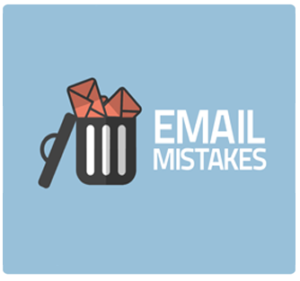
Images, Links, and Graphics
1. Your HTML Email is Just One Giant Graphic
Most email programs block the automatic download/display of images by default, which could cause your recipients to delete your email or even mark it as spam. As a general guideline, we recommend a ratio of 80 percent text to 20 percent images in an email campaign. However, all spam filters use different criteria for what is a healthy balance of graphics and text.
If your entire email campaign is a large graphic/image, add text to the footer area like your unsubscribe link, physical address, and list permission reminder to help balance out the text-to-image ratio. However, as a good rule of thumb, if its important and you want your email recipients to see/read your message, don’t make it a graphic/image, make it text.
2. Images Hosted on a Local or Private Server
If you save images on your local pc, server or network drive, the general public doesn’t have access to those servers and images will appear broken. To avoid this, upload and host all images on a public web server so that they display correctly in your email or use a CDN or even better yet use an email marketing service. Don’t insert images as attachments, which forces your email recipients to download the images you are inserting. Do you really mean to send your clients copies of your logo, facebook icon, twitter icon, etc?
3. Images and Hyperlinks Don’t Have/Use Absolute Paths
Absolute paths for images and files include your server information in addition to the file name so outside applications can find and access the file. Always host all of your images on your server and use absolute paths that point back to your server.
So, instead of coding an image like this:
<img src=”/images/photo.gif“>
You would code it like this:
<img src=”http://www.mysite.com/email/images/photo.gif “>
The same thing goes for hyperlinks. Instead of a link like this:
<a href=”index.html” shape=”rect”>Visit my website</a>
You’d code the link like this:
<a href=”http://www.mysite.com/index.html” shape=”rect”>Visit my website</a>
If you code your emails locally with a WYSIWYG, double check that all <img/> tags use absolute paths. A good tip is to upload all your email’s graphics to your web server at the very beginning of your project so you have to use absolute paths from the start.
Preview and Test
4. Campaign Wasn’t Fully Tested
Before you send your email campaign to your entire list, thoroughly test it first. I’d recommend that you send test emails to all common email services, like Yahoo, Hotmail, and Gmail. If you know your contacts use a less common email client, consider taking the steps to test in that program, as well.
5. Emails Created by a Web Designer Weren’t Tested
If you asked someone else to create your email for you and paste in the code he or she gave you, you should still send yourself test campaigns and make sure everything displays the way it should. Check that it wasn’t designed too wide to fit in the preview pane of most major email programs. Test the images and links to make sure they work as expected and are set up as absolute paths.
Code and Software
6. Microsoft FrontPage, Word, or Publisher Was Used to Create HTML Content
Using MS Word, Publisher, or FrontPage to generate HTML content can result in extra code being added to your email campaigns code. This can break your email design or result in your campaign getting filtered as spam. Instead, use a basic text editor like notepad.
7. JavaScript in HTML Email
Most email applications block JavaScript as a security measure. Make sure your code doesn’t contain any JavaScript such as on form submit buttons, pop-up window links, image pre-loaders, and widgets. If you copy/paste text from a web page, be sure to clean the code of all JavaScript before pasting it into your email template.
8. CSS Used Incorrectly
Most email applications strip HEAD and BODY tags from incoming email to keep embedded CSS from interfering with their web pages CSS. We recommend you use inline CSS or that you embed your CSS just above your content below the <BODY> tag.
Compliance
9. Using Spammy Content
Most of us receive spam. The subject lines tend to be in all caps, words in the email are bold and highlighted bright red or bright blue, they use lots of exclamation points, and they use phrases like “hottest,” “best,” or “click now!” or “Click here”
Keep your subject lines brief and to the point, keep your content relevant, don’t try to use gimmicky catch phrases, and always avoid spammy words.
10. No Unsubscribe Link
Most email marketing systems require that all emails have an unsubscribe link. There’s absolutely no exception to this rule. I’ve had some customers tell me they don’t need to add/include an unsubscribe link in their emails because they were emailing their customers and by law they have a right to email them. I explained to them that as true as that is, at the same time, your customer has the right to not receive your emails and need an easy way to opt-out.
11. No Permission Reminder
Most email marketing systems today have built-in templates that will automatically ask you to create a permission reminder but if you code your own, include one in your template code. Permission reminders briefly tell your subscribed contacts how they got on your list, for example, “You received this email because you subscribed at www.example.com for our newsletter.” Permission reminders help prevent false abuse complaints, if you receive too many abuse complaints, your company’s domain name could be blacklisted.
12. No Postal Address
A valid physical mailing address is required on all emails in compliance with the U.S. CAN-SPAM law. So if you’re coding your own emails you will need to be sure to add it.

